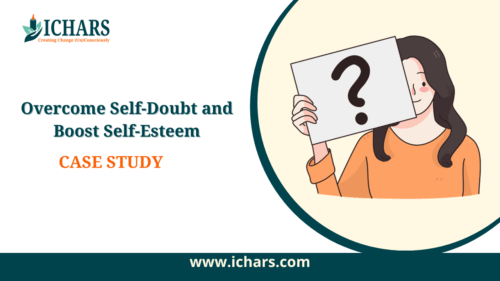Initial Consultation:
Understanding the Client’s Struggles with Self-Doubt
Anna (name changed) reached out to me after experiencing recurrent feelings of insecurity and low self-esteem. We scheduled an Initial Consultation to discuss strategies for overcoming self-doubt. During this session, Anna openly shared her personal challenges.
At 35, she was unmarried, struggling with morbid obesity, and navigating an unstable romantic relationship. These factors contributed to her low self-confidence and negative self-image. Her craving for validation from her partner, combined with emotional eating, created a recurring cycle of self-doubt and self-loathing, which affected both her personal and professional life.
Anna’s self-doubt also limited her career growth. Despite being highly qualified, she avoided marketing her clinical practice and felt stagnant professionally.
Creating a Path to Overcoming Self-Doubt
I explained how my approach as a Cognitive Hypnotic Coach & Psychotherapist uses a structured plan combining multiple techniques to help clients overcome self-doubt and build self-esteem.
I introduced her to The Model of the Mind, showing how subconscious patterns create limiting beliefs. We framed her current situation as Point A and her desired transformation as Point B, outlining a roadmap for weekly sessions to move her from self-doubt toward confidence.
We discussed the ICHARS SOFT SEA model, which identifies and addresses obstacles systematically, allowing for measurable progress. Anna was encouraged to articulate her challenges using a simple template:

“I feel ____ about ____ when ____.”
Anna identified several challenges:
- “I feel horrible and ashamed about my body weight when I am unable to do normal tasks in public.”
- “I feel helpless about not being in a stable relationship when I look at my age.”
- “I feel underconfident about not being valued for my real self when people dismiss my opinions.”
- “I feel bad about not growing my clinical practice despite my qualifications and experience.”
Her primary focus became:
“I feel underconfident about not being valued for my real self when people dismiss my opinions.”
Her desired outcome was:
“I wish to be confident in all aspects of my life and remain undisturbed by unnecessary speculation around me.”
This clarity motivated Anna to begin the therapy process with a sense of purpose.
Session 1: Using Transformational Metaphors for Overcoming Self-Doubt
In the first session, we revisited her Point A and Point B statements. Using a Transformational Metaphor, Anna explored the gap between her current life and her desired future.
This process helped her visualize actionable steps to overcome self-doubt, empowering her to take baby steps toward her goals. Together, we drafted three practical tasks for the upcoming week.

Session 2: Visualizing the Future to Boost Confidence
A week later, Anna reported completing her initial tasks. She noticed subtle improvements: reduced binge eating, less reliance on validation from her partner, and stronger self-control.
We introduced the Miracle Question and documented her desired future in a sensory-specific, present-tense format. This technique helps the subconscious gradually align actions with goals, supporting the journey of overcoming self-doubt and enhancing self-esteem.
Session 3: Breaking Down Goals into Manageable Tasks
Anna was excited to share her completed sensory-specific future document. Together, we created a detailed roadmap of tasks and subtasks, assigning realistic timelines for accountability.
Due to her morbid obesity and PCOS, we tailored her plan to include consulting medical professionals for weight management rather than forcing strenuous exercise. She also began planning improvements for her clinical practice.
Session 4: Restructuring Thoughts and Anchoring Positive Emotions
Anna faced triggers related to her brother and partner, which reignited self-doubt. Using the CHCP model, we applied Thought Restructuring and Emotional Anchoring:
- Trigger: Mockery or dismissive behavior
- Current Thought: “I am not good enough”
- Desired Thought: “I am enough, and others’ mockery does not define me”
- New Emotion: Confidence
This helped her replace negative thought patterns with empowering beliefs, a crucial step in overcoming self-doubt. She also committed to tasks for her clinic, diet, and personal growth.
Session 5: Complete Induction and Sensory-Specific Future Visualization
Anna successfully set boundaries with her family and partner, experiencing increased confidence. Using a full induction session, we reinforced her sensory-specific future and recorded it for daily practice over 21 days.
She was also introduced to Self-Hypnosis, a tool to maintain confidence and resilience, further supporting her journey of overcoming self-doubt.
Session 6: Void Management for Stress Release

Despite progress, Anna occasionally felt stressed. Using Void Management, we traced and released non-serving emotions, replacing them with constructive insights. This technique provided clarity, reduced self-doubt, and reinforced her confidence.
Session 7: Timeline Review and Consolidation
In the final session, we used the Timeline Technique to visualize her life from birth to the present. Anna reflected on her progress and noticed both subtle and significant changes in her self-confidence and daily life. This exercise reinforced the lessons learned and highlighted remaining areas for growth.
Therapist’s Reflection on Overcoming Self-Doubt
Working with Anna demonstrated how focusing on a primary challenge can unravel multiple interconnected issues. By addressing her core issue—underconfidence and lack of self-value—Anna experienced improvements in personal, emotional, and professional areas.
The integrative techniques used in her therapy included:
- SOFT SEA Coaching Model
- Meta Model Questioning
- Transformational Metaphor
- Thought Restructuring
- Emotional Anchoring
- Hypnosis & Self-Hypnosis
- Void Management
- Timeline Technique
By combining these methods into a customized plan, Anna achieved a sustainable transformation, successfully overcoming self-doubt and boosting her self-esteem.

